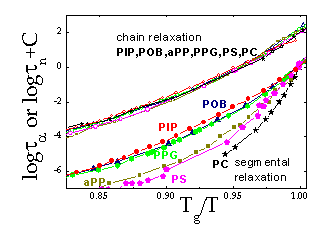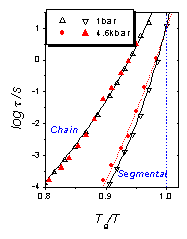
ACS PRF | ACS
All e-Annual Reports

41944-AC7
Breakdown of Time-Temperature Superposition Principle in Relaxation Properties of Polymers
Time temperature superposition (TTS) principle is one of the basic stones in Polymer Science that helps to analyze relaxation behavior of polymers in extremely broad frequency and temperature range. It assumes, in particular, that segmental and chain friction coefficients have the same mechanism. Although the failure of TTS in many polymers has been known for more than 40 years, its microscopic mechanism remains unknown.
We applied dielectric relaxation and light scattering spectroscopy to analysis of chain and segmental dynamics in polymers. These techniques combined cover the entire frequency range from mHz to THz (more than 15 orders). Thus the spectra can be measured without involving any assumptions on time-temperature superposition. In addition, we also studied influence of pressure on chain and segmental dynamics and used a broad analysis of literature data to emphasize universality of our findings.
Our analysis indicates that TTS breaks down in the entire temperature range [1,2]: Chain relaxation varies with temperature slower than segmental relaxation at low temperatures (close to the glass transition Tg), while opposite behavior is observed at higher temperatures [2]. The change in the behavior appears around the so-called dynamic crossover temperature TC [1,2]. The most intriguing observation is the universality of the temperature dependence of the chain relaxation when it is analyzed vs Tg/T [1,2] (Fig.1). It appears that polymers with different chemical structure and various molecular weights, entangled and non-entangled, exhibit universal behavior of the chain relaxation time tC vs Tg/T, while behavior of segmental relaxation time tS for the same polymers differs strongly [1,2]. Application of high-pressure leads to significant change of the behavior of segmental relaxation while behavior of the chain relaxation remains the same (Fig.2) [4]. We also observe significant change in TC with molecular weight. However, it appears around the same segmental relaxation time tS~10-7±1s [3]. No sign of the dynamic crossover has been observed for the chain relaxation [3].
Our results suggest that chain dynamics is decoupled from the segmental dynamics. Temperature variations of segmental dynamics depend strongly on chemical structure, dynamic heterogeneity and cooperativity of segmental motions. Influence of all these parameters are apparently averaged out on the time and length scale of the chain relaxation. The polymers behave as long flexible chains where flexibility is apparently related to Tg. This observation suggests that knowledge of polymer's Tg might be sufficient to predict thermal variation of its viscosity, regardless of the chemical structure and molecular weight. These results cannot be explained by any existing theory of the chain relaxation and provides a breakthrough in our understanding of polymer dynamics.
In addition, we analyzed spectral shape of the chain relaxation and its dependence on molecular weight [5]. We used dielectric spectroscopy that provides significant advantages relative to traditional mechanical relaxation measurements. We show that the traditional reptation/Rouse model cannot describe the spectra. However, recent modification of the reptation theory that includes contour-length fluctuations, constrained release and longitudinal modes provides good description even on a quantitative level.
Two PhD students (Y.Ding and K. Kunal) and two postdocs (Y. Hayashi and S. Pawlus) were involved in this project. The work also involved collaboration with M. Roland (NRL, USA), M. Paluch (Poland) and A. Likhtman (UK).
Summary of the main results:
- Universality of the chain relaxation, its explanation requires significant revision of the current theory of polymer dynamics.
- Breakdown of TTS in the entire temperature range, it indicates complete decoupling of chain and segmental dynamics.
- Molecular weight dependence of the dynamic crossover and its role in the breakdown of TTS.
- Spectra of the chain modes cannot be described by the traditional Rouse/reptation theory, but agree well with the recent modifications of the theory.
Figure 1: Temperature dependence of chain relaxation presented vs Tg/T appears to be universal for different polymers, although their segmental relaxation differs strongly [1]. |
Figure 2: Behavior of chain relaxation remains the same even at high pressure (P=4.6 kbar) when segmental dynamics change its behavior [4]. |
- Y. Ding, A.P. Sokolov, Macromolecules 39, 3322-3326 (2006).
- A.P. Sokolov, Y. Hayashi, J.Non-Cryst.Solids 353, 3838-3844 (2007).
- S. Pawlus, K. Kunal, L. Hong, A.P. Sokolov, Macromolecules (in preparation).
- S. Pawlus, M. Paluch, A.P. Sokolov, Macromolecules (in preparation).
- A. Macy, K. Kunal, M. Paluch, A. Likhtman, A. P. Sokolov, Macromolecules (in preparation).

